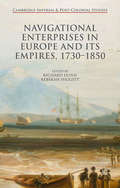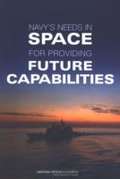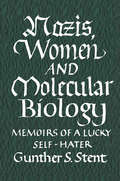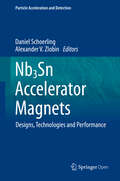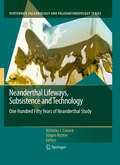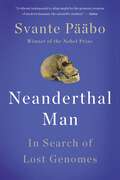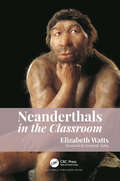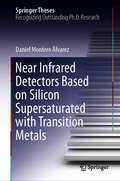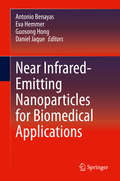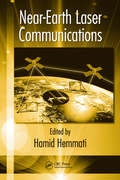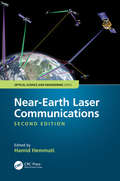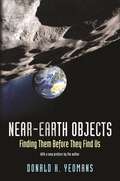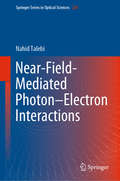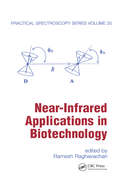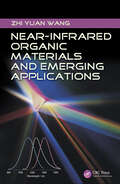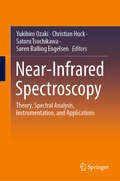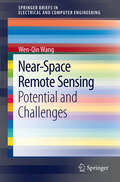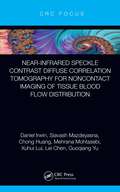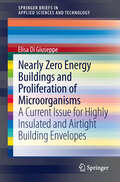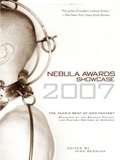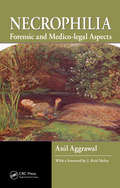- Table View
- List View
Navigational Enterprises in Europe and its Empires, 1730–1850 (Cambridge Imperial and Post-Colonial Studies Series)
by Richard Dunn Rebekah HiggittThis book explores the development of navigation in the eighteenth and nineteenth centuries. It examines the role of men of science, seamen and practitioners across Europe, and the realities of navigational practice, showing that old and new methods were complementary not exclusive, their use dependent on many competing factors.
Navy's Needs In Space For Providing Future Capabilities
by National Research Council of the National AcademiesThe United States must operate successfully in space to help assure its security and economic well being. The Department of the Navy is a major user of space capabilities, although those capabilities are now primarily provided by DOD, the Air Force, and NOAA. Following a DOD assessment of national space security management in 2001, the Navy commissioned a Panel to Review Space to assess Navy space policy and strategy. As an extension of that review, the NRC was requested by the Navy to examine its needs in space for providing future operational and technical capabilities. This report presents a discussion of the strategic framework of future space needs, the roles and responsibilities for meeting those needs, an assessment of Navy support to space mission areas, and a proposed vision for fulfilling Naval forces space needs.
Nazi Eugenics: Precursors, Policy, Aftermath
by Melvyn ConroyConceived as the answer to all of mankind's seemingly insoluble health and social problems, and promoted as a substitute for orthodox religious beliefs, the pseudoscience of eugenics recruited disciples in many countries during the latter years of the nineteenth and early years of the twentieth centuries. Nowhere was this doctrine more enthusiastically endorsed than in Germany, where the application of eugenic theory received its most fervent support. A program born of what were often contradictory opinions began, under Nazi rule, with the compulsory sterilization of thousands of Germany's citizens before morphing into the mass murder of the most vulnerable of the state's own population under the guise of so-called "euthanasia," before ultimately escalating into a continent-wide policy of extermination of those who did not fit the Nazi eugenic template.The progress of this inexorable descent into barbarity was marked by successive stages of development. From the practical application of euthanasia through the organization dedicated to it—later on called Aktion T4—and the killing centers that this institution spawned, to the centrality of Aktion T4 to Aktion Reinhardt and the Holocaust, important elements of the historical record can be seen to emerge. How did it happen? What impact has it had on contemporary society? And what of the character and fate of the individuals involved in the gestation and implementation of this murderously inhumane quasi-religion? These deceptively simple questions require complex and often disturbing answers, as shown by Melvyn Conroy in this important work.
Nazi Science: Myth, Truth, And The German Atomic Bomb
by Mark WalkerIn this book, Mark Walker - a historical scholar of Nazi science - brings to light the overwhelming impact of Hitler's regime on science and, ultimately, on the pursuit of the German atomic bomb. Walker meticulously draws on hundreds of original documents to examine the role of German scientists in the rise and fall of the Third Reich. He investigates whether most German scientists during Hitler's regime enthusiastically embraced the tenets of National Socialism or cooperated in a Faustian pact for financial support, which contributed to National Socialism's running rampant and culminated in the rape of Europe and the genocide of millions of Jews. This work unravels the myths and controversies surrounding Hitler's atomic bomb project. It provides a look at what surprisingly turned out to be an Achilles' heel for Hitler - the misuse of science and scientists in the service of the Third Reich.
Nazis, Women and Molecular Biology
by Gunther StentWhat prompts a well-renowned scientist in molecular biology to write memoirs about a part of his life? In the case of Gunther Stent, it was not to reflect on his career as a scientist, but to come to an understanding of his own soul. In his seventies, he had come to see that he had been, throughout his life, an emotional sleepwalker, especially as regards women and, in addition, that he had been troubled by Jewish self-hatred. His story may have more to do with St. Augustine's Confessions than with a scientist's memoirs. Stent provides insight into the power of political correctness, and the ability of a government to establish a perverse vision of reality. For readers interested in bioethics, Stent's memoirs help to explain how Germany could have been the first country to enact an all-encompassing protection for human research subjects while it was also the country that produced the medical experiments of the Nazis and the greatest perversion of medical morality in history. Stent is a person of intelligence and subtlety, an accomplished writer, a deep and wise man, and a loyal friend. His narrative is centered emotionally on a youth spent in Berlin in the Nazi period. As a boy of fourteen he was an eyewitness of the horrors of the Kristallnacht pogrom.On New Year's Eve 1938 he escaped from Germany across the "green frontier." He came to America in his teens, only to return to Berlin at the end of World War II as a scientific consultant for the U.S. Military. On his return to the States, Stent participated in the exciting early scientific breakthroughs of molecular biology that transformed the twentieth-century life sciences. His Nazis, Women and Molecular Biology is a piercing self-examination, and as its review in Science Newsletter says, "an act of self-exposure, abnegation, contrition, and expiation." It will be of keen interest to those who have inhabited Stent's worlds or shared his experiences, as well as those who wish to learn more about them. Gunther S. Stent is professor emeritus of neurobiology at the University of California, Berkeley. He is the author of such classic texts as Molecular Biology of Bacterial Viruses and Molecular Genetics, as well as philosophical books, such as The Coming of the Golden Age, Paradoxes of Progress, and, most recently (2002), Paradoxes of Free Will.
Nb3Sn Accelerator Magnets: Designs, Technologies and Performance (Particle Acceleration and Detection)
by Daniel Schoerling Alexander V. ZlobinThis open access book is written by world-recognized experts in the fields of applied superconductivity and superconducting accelerator magnet technologies. It provides a contemporary review and assessment of the experience in research and development of high-field accelerator dipole magnets based on Nb3Sn superconductor over the past five decades. The reader attains clear insight into the development and the main properties of Nb3Sn composite superconducting wires and Rutherford cables, and details of accelerator dipole designs, technologies and performance. Special attention is given to innovative features of the developed Nb3Sn magnets. The book concludes with a discussion of accelerator magnet needs for future circular colliders.
Neanderthal Lifeways, Subsistence and Technology
by Nicholas J. Conard Jürgen RichterThe 150th anniversary of the discovery of the famous Neanderthal fossils gave reason for an international and interdisciplinary symposium in Bonn/Germany. The present book arose from this congress and focuses on multiple aspects of archaeological investigation on Neanderthal lifeways. In-depth studies of top-ranking scientists provide a detailed and comprehensive survey of contemporary research on our Pleistocene relatives. Examinations and debates are embedded in a variety of regions and time frames. Chronology, subsistence, land use, and cultural adaptations among late Neanderthals form the major trajectories of the book. The wide range of approaches involved, leads to an increasing understanding of the facets of and the variability of Neanderthal behavioural patterns. The present volume is complemented by a paleontologically orientated publication of the same congress (edited by Gerd-Christian Weniger and Silvana Condemi).
Neanderthal Man: In Search of Lost Genomes
by Svante PaaboA preeminent geneticist hunts the Neanderthal genome to answer the biggest question of them all: what does it mean to be human? What can we learn from the genes of our closest evolutionary relatives? Neanderthal Man tells the story of geneticist Svante Pääbo’s mission to answer that question, beginning with the study of DNA in Egyptian mummies in the early 1980s and culminating in his sequencing of the Neanderthal genome in 2009. From Pääbo, we learn how Neanderthal genes offer a unique window into the lives of our hominin relatives and may hold the key to unlocking the mystery of why humans survived while Neanderthals went extinct. Drawing on genetic and fossil clues, Pääbo explores what is known about the origin of modern humans and their relationship to the Neanderthals and describes the fierce debate surrounding the nature of the two species’ interactions. A riveting story about a visionary researcher and the nature of scientific inquiry, Neanderthal Man offers rich insight into the fundamental question of who we are.
Neanderthals in the Classroom
by Elizabeth Marie WattsNeanderthals in the Classroom examines the ongoing battle surrounding evolution from a cultural and historical perspective and then puts Theodosius Dobzhansky’s claim that “nothing in biology makes sense except in the light of evolution” to the ultimate test by exploring the potential evolutionary roots of this societal and educational clash over human origins. In examining the biological roots of the conflict, Watts demonstrates how understanding our inner Neanderthal allows us to consciously choose more highly evolved forms of communication as a means of alleviating societal division and creating space for more effective science education. Key Features: Introduces readers to the multifaceted world of evolution education. Describes the complex interplay between religious beliefs and science as well as the clash of false information and formal education. Offers an overview of the transformation of public opinion of evolution and science over time in the United States due to the perceived conflict between science and religion. Examines students’ misconceptions about the theory of evolution and the general nature of scientific discovery due to the contradictory messages that they receive in popular culture. Offers potential means to amend misconceptions so that students and other individuals can integrate evolutionary theory into their worldviews, regardless of their religious background.
Near Infrared Detectors Based on Silicon Supersaturated with Transition Metals (Springer Theses)
by Daniel Montero ÁlvarezThis thesis makes a significant contribution to the development of cheaper Si-based Infrared detectors, operating at room temperature. In particular, the work is focused in the integration of the Ti supersaturated Si material into a CMOS Image Sensor route, the technology of choice for imaging nowadays due to its low-cost and high resolution. First, the material is fabricated using ion implantation of Ti atoms at high concentrations. Afterwards, the crystallinity is recovered by means of a pulsed laser process. The material is used to fabricate planar photodiodes, which are later characterized using current-voltage and quantum efficiency measurements. The prototypes showed improved sub-bandgap responsivity up to 0.45 eV at room temperature. The work is further supported by a collaboration with STMicroelectronics, where the supersaturated material was integrated into CMOS-based sensors at industry level. The results show that Ti supersaturated Si is compatible in terms of contamination, process integration and uniformity. The devices showed similar performance to non-implanted devices in the visible region. This fact leaves the door open for further integration of supersaturated materials into CMOS Image Sensors.
Near Infrared-Emitting Nanoparticles for Biomedical Applications
by Daniel Jaque Antonio Benayas Eva Hemmer Guosong HongThis book analyzes and evaluates the growing field of light-emitting nanoprobes as contrast agents for in vivo imaging and sensing. It is a comprehensive resource that critically analyzes the state of the art in an interdisciplinary manner, with a special focus on the shift of emission wavelengths into the near-infrared (NIR) spectral region (ranging from 0.7 to 2 microns), which has greatly contributed to the latest advances in biomedical imaging and sensing. This book discusses merits of different contrast agents at nanoscale, and how their unique chemical and structural properties lead to the emission and interaction of light within the NIR window. Both the NIR-emitting materials and various surface modification strategies governing their interactions with the biological system at the “nano” level are discussed. Furthermore, different experimental techniques and protocols for NIR-light-based in vivo imaging and sensing are addressed to shed light on further understanding of the advantages and limitations of each category of these nanoprobes. Assembles the state of the art heretofore appearing in scientific literature into a comprehensive, multi-perspective guidebook on near infrared-emitting nanomaterials in an assortment of biomedical applications;Explains the physical, chemical, and biological phenomena underlying near infrared-emitting nanomaterials for biomedical applications;Presents conceptual and experimental approaches surrounding a unique spectral range of light emission from nanosized contrast agents, while offering a clear explanation of basic and general phenomena regarding the interaction between light and biological tissues, such as absorption, scattering and autofluorescence.
Near-Earth Laser Communications (Optical Science and Engineering #1)
by Hamid HemmatiInvented more than a hundred years ago by Alexander Graham Bell, the technology of free-space optical communications, or lasercom, has finally reached the level of maturity required to meet a growing demand for operational multi-giga-bit-per-second data rate systems communicating to and from aircrafts and satellites. Putting the emphasis on near-earth links, including air, LEO, MEO, and GEO orbits, Near-Earth Laser Communications presents a summary of important free-space laser communication subsystem challenges and discusses potential ways to overcome them. This comprehensive reference provides up-to-date information on component and subsystem technologies, fundamental limitations, and approaches to reach those limits. It covers basic concepts and state-of-the-art technologies, emphasizing device technology, implementation techniques, and system trades. The authors discuss hardware technologies and their applications, and also explore ongoing research activities and those planned for the near future. The analytical aspects of laser communication have been covered to a great extent in several books. However, a detailed approach to system design and development, including trades on subsystem choices and implications of the hardware selection for satellite and aircraft telecommunications, is missing. Highlighting key design variations and critical differences between them, this book distills decades’ worth of experience into a practical resource on hardware technologies.
Near-Earth Laser Communications, Second Edition (Optical Science and Engineering #1)
by Hamid HemmatiThis reference provides an overview of near-Earth laser communication theory developments including component and subsystem technologies, fundamental limitations, and approaches to reach those limits. It covers basic concepts and state-of-the-art technologies, emphasizing device technology, implementation techniques, and system trades. The authors discuss hardware technologies and their applications, and also explore ongoing research activities and those planned for the near future. This new edition includes major to minor revisions with technology updates on nearly all chapters.
Near-Earth Object Surveys and Hazard Mitigation Strategies: Interim Report
by National Research Council of the National AcademiesThe United States is currently the only country with an active, government-sponsored effort to detect and track potentially hazardous near-Earth objects (NEOs). Congress has mandated that NASA detect and track 90 percent of NEOs that are 1 kilometer in diameter or larger. These objects represent a great potential hazard to life on Earth and could cause global destruction. NASA is close to accomplishing this goal. Congress has more recently mandated that by 2020 NASA should detect and track 90 percent of NEOs that are 140 meters in diameter or larger, a category of objects that is generally recognized to represent a very significant threat to life on Earth if they strike in or near urban areas. Achieving this goal may require the building of one or more additional observatories, possibly including a space-based observatory. Congress directed NASA to ask the National Research Council to review NASA's near-Earth object programs. This interim report addresses some of the issues associated with the survey and detection of NEOs. The final report will contain findings and recommendations for survey and detection, characterization, and mitigation of near-Earth objects based on an integrated assessment of the problem.
Near-Earth Objects: Finding Them Before They Find Us
by Donald K. YeomansAn insider's look at the science of near-Earth comets and asteroidsOf all the natural disasters that could befall us, only an Earth impact by a large comet or asteroid has the potential to end civilization in a single blow. Yet these near-Earth objects also offer tantalizing clues to our solar system's origins, and someday could even serve as stepping-stones for space exploration. In this book, Donald Yeomans introduces readers to the science of near-Earth objects—its history, applications, and ongoing quest to find near-Earth objects before they find us.In its course around the sun, the Earth passes through a veritable shooting gallery of millions of nearby comets and asteroids. One such asteroid is thought to have plunged into our planet sixty-five million years ago, triggering a global catastrophe that killed off the dinosaurs. Yeomans provides an up-to-date and accessible guide for understanding the threats posed by near-Earth objects, and also explains how early collisions with them delivered the ingredients that made life on Earth possible. He shows how later impacts spurred evolution, allowing only the most adaptable species to thrive—in fact, we humans may owe our very existence to objects that struck our planet.Yeomans takes readers behind the scenes of today’s efforts to find, track, and study near-Earth objects. He shows how the same comets and asteroids most likely to collide with us could also be mined for precious natural resources like water and oxygen, and used as watering holes and fueling stations for expeditions to Mars and the outermost reaches of our solar system.
Near-Field-Mediated Photon–Electron Interactions (Springer Series in Optical Sciences #228)
by Nahid TalebiThis book focuses on the use of novel electron microscopy techniques to further our understanding of the physics behind electron–light interactions. It introduces and discusses the methodologies for advancing the field of electron microscopy towards a better control of electron dynamics with significantly improved temporal resolutions, and explores the burgeoning field of nanooptics – the physics of light–matter interaction at the nanoscale – whose practical applications transcend numerous fields such as energy conversion, control of chemical reactions, optically induced phase transitions, quantum cryptography, and data processing.In addition to describing analytical and numerical techniques for exploring the theoretical basis of electron–light interactions, the book showcases a number of relevant case studies, such as optical modes in gold tapers probed by electron beams and investigations of optical excitations in the topological insulator Bi2Se3. The experiments featured provide an impetus to develop more relevant theoretical models, benchmark current approximations, and even more characterization tools based on coherent electron–light interactions.
Near-Infrared Applications in Biotechnology (Practical Spectroscopy #Vol. 25)
by Ramesh RaghavachariThis volume explores developments in techniques in diagnostics, DNA sequencing, bioanalysis of immunoassays, and single-molecule detection. It promotes the measurement, identification, monitoring, analysis, and application of near-infrared spectroscopy (NIR) to medical and pharmaceutical advances. The text also considers noninvasive methods of NIR for successful, cost-effective, and prompt diagnoses of diseases.
Near-Infrared Organic Materials and Emerging Applications
by Zhi Yuan WangTo physicists and chemists, color means light-emission, absorption, spectrum, and coloration. Near-Infrared Organic Materials and Emerging Applications presents knowledge and applications of invisible "colored" organic materials. Near-infrared (NIR) materials are defined as substances that interact with NIR light, namely, absorption and reflection,
Near-Infrared Spectroscopy: Theory, Spectral Analysis, Instrumentation, and Applications
by Yukihiro Ozaki Christian Huck Satoru Tsuchikawa Søren Balling EngelsenThis book provides knowledge of the basic theory, spectral analysis methods, chemometrics, instrumentation, and applications of near-infrared (NIR) spectroscopy—not as a handbook but rather as a sourcebook of NIR spectroscopy. Thus, some emphasis is placed on the description of basic knowledge that is important in learning and using NIR spectroscopy. The book also deals with applications for a variety of research fields that are very useful for a wide range of readers from graduate students to scientists and engineers in both academia and industry. For readers who are novices in NIR spectroscopy, this book provides a good introduction, and for those who already are familiar with the field it affords an excellent means of strengthening their knowledge about NIR spectroscopy and keeping abreast of recent developments.
Near-Space Remote Sensing
by Wen-Qin WangNear-space is defined as the atmospheric region from about 20 kilometer (km) altitude to 100 km altitude above the Earth's surface. It has received much attention in recent years and several types of near-space vehicles are currently being studied, developed, or employed. "Near-Space Remote Sensing: Potential and Challenges" concentrates mainly on the role of near-space vehicles in bridging the gap between satellites and airplanes for microwave remote sensing applications, providing a top-level system description and aiming to encourage further research. Further, this book also describes several potential applications such as passive surveillance, reconnaissance, and high resolution wide swath remote imaging. The book is intended for geographers, transportation engineers and other researchers involved in remote sensing development and applications, in particular for near-space vehicles. Wen-Qin Wang is an assistant professor at the School of Communication and Information Engineering, University of Electronic Science and Technology of China.
Near-infrared Speckle Contrast Diffuse Correlation Tomography for Noncontact Imaging of Tissue Blood Flow Distribution
by Lei Chen Daniel Irwin Siavash Mazdeyasna Chong Huang Mehrana Mohtasebi Xuhui Lui Guoqiang YuImaging of tissue blood flow (BF) distributions provides vital information for the diagnosis and therapeutic monitoring of various vascular diseases. The innovative near-infrared speckle contrast diffuse correlation tomography (scDCT) technique produces full 3D BF distributions. Many advanced features are provided over competing technologies including high sampling density, fast data acquisition, noninvasiveness, noncontact, affordability, portability, and translatability across varied subject sizes. The basic principle, instrumentation, and data analysis algorithms are presented in detail. The extensive applications are summarized such as imaging of cerebral BF (CBF) in mice, rat, and piglet animals with skull penetration into deep brain. Clinical human testing results are described by recovery of BF distributions on preterm infants (CBF) through incubator wall, and on sensitive burn tissues and mastectomy skin flaps without direct device-tissue interactions. Supporting activities outlined include integrated capability for acquiring surface curvature information, rapid 2D blood flow mapping, and optimizations via tissue-like phantoms and computer simulations. These applications and activities both highlight and guide the reader as to the expected abilities and limitations of scDCT for adapting into their own preclinical/clinical research, use in constrained environments (i.e., neonatal intensive care unit bedside), and use on vulnerable subjects and measurement sites.
Nearest Star
by Jay M. Pasachoff Leon GolubUnlike the myriad points of light we gaze at in the night sky, our nearest star allows us to study the wonders of stellar workings at blindingly close range--from a mere 93 million miles away. And what do we see? In this book, two of the world's leading solar scientists unfold all that history and science--from the first cursory observations to the measurements obtained by the latest state-of-the-art instruments on the ground and in space--have revealed about the Sun. Following the path of science from the very center of this 380,000,000,000,000,000,000-megawatt furnace to its explosive surface, Nearest Star invites readers into an open-ended narrative of discovery about what we know about the Sun and how we have learned it. How did the Sun evolve, and what will it become? What is the origin of its light and heat? How does solar activity affect the atmospheric conditions that make life on earth possible? These are the questions at the heart of solar physics, and at the center of this book. Having made optical solar observations with many solar telescopes and in the rockets and satellites, the authors bring their extensive personal experience to this story of how astronomers study the Sun, and what they have discovered about phenomena from eclipses to neutrinos, space weather, and global warming. Richly illustrated with an assortment of pictures from the latest solar missions and the newest telescopes, this book is a very readable, up-to-date account of science's encounter with our nearest star.
Nearly Zero Energy Buildings and Proliferation of Microorganisms
by Elisa Di GiuseppeThis book provides a concise review of the thermo-physical phenomena which regulate heat and moisture transportation in Nearly Zero Energy Buildings envelopes, and their relationship with the growth of biological organisms. It describes the main microorganisms proliferating on contemporary building elements and within buildings. It also states the consequences of biological growth on durability, aesthetics and human health; and provides the main methods for the analytical and experimental evaluation of proliferation. Finally, through the review of recent developments, remedial actions to counter the biological phenomenon are examined, and an outline is provided for future innovations in a field not yet widely investigated.
Nebula Awards Showcase 2007
by Mike ResnickThis annual publication as chosen by the Science Fiction and Fantasy Writers of America brings together the best of the year's stories, as well as essays and commentary on the current state of the genre and predictions of future science fiction and fantasy films, art, and more. This year's award-winning authors include Joe Haldeman (Novel), Kelly Link (Novella, Novelette), and Carol Emshwiller (Short Story).
Necrophilia: Forensic and Medico-legal Aspects
by Anil AggrawalNecrophilia: Forensic and Medico-legal Aspects is the first text that deals with the scientific aspects of necrophilia from a multidisciplinary point of view. After an introduction that provides a general scientific, social, and historical perspective, this volume:Explores causes and contributing factors, covering biological theories and genetics, as well as trauma, brain anomalies, and substance abuseOffers an original approach to classification, creating ten levels of severity from role playing to homicidal necrophiliaDiscusses necrophilia epidemiology, exploring offender characteristics and habitsProvides 20 case studies of infamous as well as less publicized casesDetails the forensics approach to necrophilia investigationExamines current legislation and mores across the worldExplains the challenges involved with providing expert testimony
